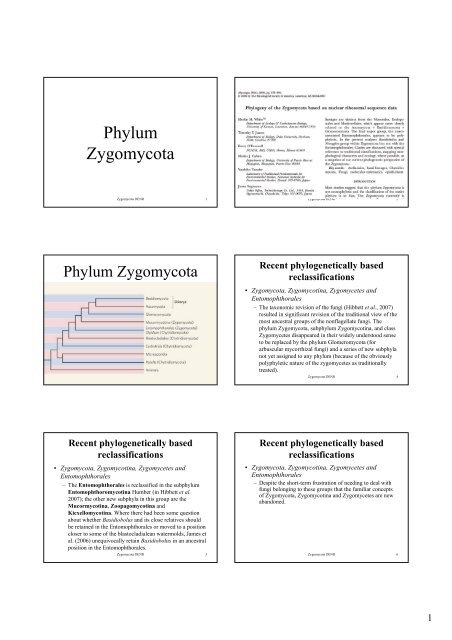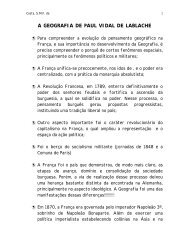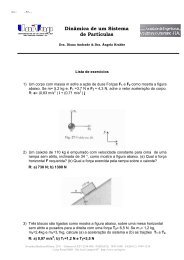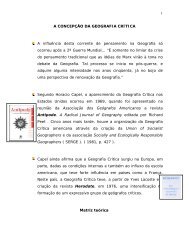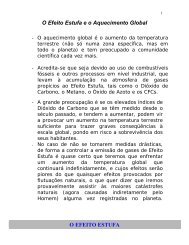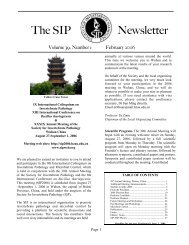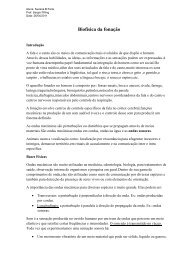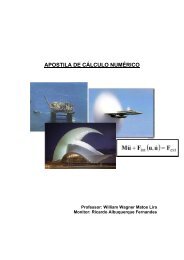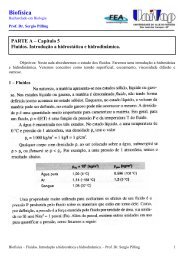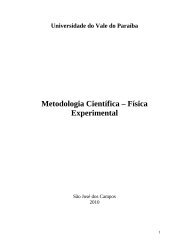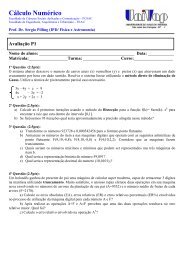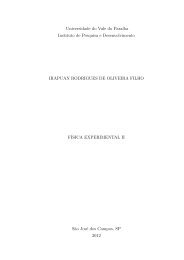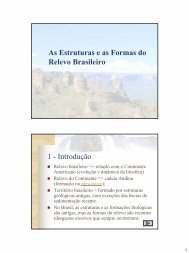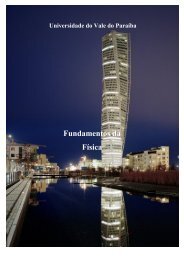F0007 - Phylum Zygomycota and the new classification - Univap
F0007 - Phylum Zygomycota and the new classification - Univap
F0007 - Phylum Zygomycota and the new classification - Univap
Create successful ePaper yourself
Turn your PDF publications into a flip-book with our unique Google optimized e-Paper software.
<strong>Phylum</strong><strong>Zygomycota</strong><strong>Zygomycota</strong> DENR 1<strong>Zygomycota</strong> DENR 2<strong>Phylum</strong> <strong>Zygomycota</strong><strong>Zygomycota</strong> DENR 3Recent phylogenetically basedre<strong>classification</strong>s• <strong>Zygomycota</strong>, Zygomycotina, Zygomycetes <strong>and</strong>Entomophthorales– The taxonomic revision of <strong>the</strong> fungi (Hibbett et al., 2007)resulted in significant revision of <strong>the</strong> traditional view of <strong>the</strong>most ancestral groups of <strong>the</strong> nonflagellate fungi. Thephylum <strong>Zygomycota</strong>, subphylum Zygomycotina, <strong>and</strong> classZygomycetes disappeared in <strong>the</strong>ir widely understood senseto be replaced by <strong>the</strong> phylum Glomeromycota (forarbuscular mycorrhizal fungi) <strong>and</strong> a series of <strong>new</strong> subphylanot yet assigned to any phylum (because of <strong>the</strong> obviouslypolyphyletic nature of <strong>the</strong> zygomycetes as traditionallytreated).<strong>Zygomycota</strong> DENR 4Recent phylogenetically basedre<strong>classification</strong>s• <strong>Zygomycota</strong>, Zygomycotina, Zygomycetes <strong>and</strong>Entomophthorales–The Entomophthorales is reclassified in <strong>the</strong> subphylumEntomophthoromycotina Humber (in Hibbett et al.2007); <strong>the</strong> o<strong>the</strong>r <strong>new</strong> subphyla in this group are <strong>the</strong>Mucormycotina, Zoopagomycotina <strong>and</strong>Kicxellomycotina. Where <strong>the</strong>re had been some questionabout whe<strong>the</strong>r Basidiobolus <strong>and</strong> its close relatives shouldbe retained in <strong>the</strong> Entomophthorales or moved to a positioncloser to some of <strong>the</strong> blastocladialean watermolds, James etal. (2006) unequivocally retain Basidiobolus in an ancestralposition in <strong>the</strong> Entomophthorales.<strong>Zygomycota</strong> DENR 5Recent phylogenetically basedre<strong>classification</strong>s• <strong>Zygomycota</strong>, Zygomycotina, Zygomycetes <strong>and</strong>Entomophthorales– Despite <strong>the</strong> short-term frustration of needing to deal withfungi belonging to <strong>the</strong>se groups that <strong>the</strong> familiar conceptsof <strong>Zygomycota</strong>, Zygomycotina <strong>and</strong> Zygomycetes are <strong>new</strong>ab<strong>and</strong>oned.<strong>Zygomycota</strong> DENR 61
Recent phylogenetically basedre<strong>classification</strong>s• <strong>Zygomycota</strong>, Zygomycotina, Zygomycetes <strong>and</strong>Entomophthorales– Until such a time as <strong>the</strong> molecular studies clarify <strong>the</strong>overall relationships among <strong>the</strong>se fungi <strong>and</strong> establish a <strong>new</strong>set of phyla, my practical advice is to continue to use <strong>the</strong>sediscontinued phylum, subphylum <strong>and</strong> class names since (1)<strong>the</strong>ir meanings remain unambiguous in terms of <strong>the</strong> fungiincluded, <strong>and</strong> (2) journals may remain unwilling or unablefor some time still to h<strong>and</strong>le <strong>the</strong> concepts of <strong>new</strong> subphylawith unassigned status (‘incertae sedis’).<strong>Zygomycota</strong> DENR 7Classificação HierárquicaReino FungiFilo <strong>Zygomycota</strong>Subfilo MucormycotinaClasse ZygomycetesOrdem MucoralesFamilía MucoraceaeGênero MucorEspécie: Mucor mucedo<strong>Zygomycota</strong> DENR 8<strong>Zygomycota</strong>• Duas Classes–Classe Zygomycetes–Classe TrichomycetesBased on 18S + 28S + 5.8SZygomycetesTrichomycetesFrom White et al. 2006. Mycologia98:872-884<strong>Zygomycota</strong> DENR 9<strong>Zygomycota</strong> DENR 10<strong>Zygomycota</strong>• Classe Zygomycetes– 10 ordens– 32 famílias– 124 gêneros– 870 espécies• Classe Trichomycetes– 3 ordens– 6 famílias– 55 gêneros– 218 espécies<strong>Zygomycota</strong> DENR 11– <strong>Phylum</strong> <strong>Zygomycota</strong>– Classe Zygomycetes» Ordem Mucorales» Ordem Entomophtorales» Ordem Zoopagales» Ordem Dimargaritales» Ordem Kickxellales» Ordem Endogonales» Ordem Glomales» Ordem Mortiellales<strong>Zygomycota</strong>– <strong>Phylum</strong> <strong>Zygomycota</strong>– Classe Trichomycetes» Ordem Harpellales» Ordem Asellariales» Ordem EccrinalesThe order Glomales was removed in 2001 <strong>and</strong> elevated to <strong>Phylum</strong>Glomeromycota due <strong>the</strong>ir lack of <strong>Zygomycota</strong> zygospore DENR formation, <strong>the</strong>ir mycorrhizal 12habit, <strong>and</strong> lack of DNA sequence homology2
<strong>Zygomycota</strong>• Classe Zygomycetes– Abundantes– Distribuídos em todo mundo– Saprótrofos– Patógenos– Causa podridão nos frutos e madeirae cogumelos.<strong>Zygomycota</strong>• Classe Trichomycetes– Parasitas obrigatórios– Vivem nos intestinos dos insetos eoutros artrópodes (endosimbiontes).<strong>Zygomycota</strong> DENR 13<strong>Zygomycota</strong> DENR 14Zygomycetes• Esporangiósporo – típico esporonão sexual formado pelos membrosdesta divisão.Formado endogenamente dentro de umesporângio.O esporângio é formado em cima de umpedúnculo chamado esporangióforoMorangos cobertos <strong>Zygomycota</strong> com DENR micelio de Rhizopus 15<strong>Zygomycota</strong> DENR 16Mucor sp.sporangiumsporangiophoreZygomycetessporangiosporescolumellaRhizopusZygomycetes• A maioria dos esporângios produzvários esporangiósporos, entretanto,algumas espécies produzem poucosou apenas um. Este esporângioreduzido é chamado deesporangiolesMucor<strong>Zygomycota</strong> DENR 17http://www.botany.utoronto.ca/ResearchLabs/MallochLab/Malloch/Moulds.html<strong>Zygomycota</strong> DENR 183
Zygomycetes• Esporangio contendo 1-50 esporos• Merosporangio éesporangioles comesporos em sérieslinearesesporangioles<strong>Zygomycota</strong> DENR 19<strong>Zygomycota</strong> DENR 20sporangiosporessporangiophorecolumella<strong>Zygomycota</strong> DENR 21 <strong>Zygomycota</strong> DENR 22Microscopic features of Rhizopus spp. inculture. (A) Low-power magnification (×4) ofRhizopus demonstrates <strong>the</strong> nodal occurrence ofwell-developed rhizoids in this genus(arrowhead). Sporangiophores are long <strong>and</strong>unbranched, usually terminating in largeglobose sporangia. In this figure, <strong>the</strong> sporangiahave become deliquescent, releasing a plethoraof sporangiospores seen dispersed in <strong>the</strong>background. The naked, somewhat collapsedcolumellae remain at <strong>the</strong> distal end of <strong>the</strong>sporangiophores (arrows). The sporangiophore<strong>the</strong>mselves are pigmented light brown. Bar,200 µm. (B) Rhizoids originate directly at <strong>the</strong>base of <strong>the</strong> sporangiophores, often from agnarled, pigmented knot at <strong>the</strong> node(arrowhead). Stolons extend laterally from <strong>the</strong>node (long arrows). The naked columella haspartially collapsed back on <strong>the</strong> sporangiophore(asterisk). At this higher power ofmagnification, <strong>the</strong> round to ovalsporangiospore morphology is readilyappreciated (short arrows). Bar, 25 µm. (C) Anintact, mature globose sporangium is seen inthis photomicrograph (arrow). The sphericalcolumella is nearly obscured by <strong>the</strong> presence of<strong>the</strong> sporangiospores in <strong>the</strong> sporangial sack. Aflattened, bare columella is also present,illustrating well <strong>the</strong> slight apophysis that isoften seen in <strong>the</strong> Rhizopus spp. (arrowhead).Bar, 50 µm. (D) Upon deliquescence, smallsporangial membrane remnants may adhere at<strong>the</strong> interface between <strong>the</strong> apophysis <strong>and</strong> <strong>the</strong>columella. These remnants are referred to as<strong>the</strong> collarette <strong>and</strong> are well illustrated in thisphotomicrograph (arrowheads). Note also <strong>the</strong>Clinical Microbiology Reviews, April 2000, p. 236-301, Vol. 13, No. 2very slight apophysis at <strong>the</strong> top of <strong>the</strong>Zygomycetes in Human Disease <strong>Zygomycota</strong> DENR sporangiophore. This columella is intact 23 <strong>and</strong>demonstrates <strong>the</strong> oval shape that may be seenJulie A. Ribes, Carolyn L. Vanover-Sams, <strong>and</strong> Doris J. Bakerin Rhizopus isolates. Bar, 25 µm.Clinical Microbiology Reviews, April 2000, p. 236-301, Vol. 13, No. 2Zygomycetes in Human DiseaseJulie A. Ribes, Carolyn L. Vanover-Sams, <strong>and</strong> Doris J. BakerReproductive structures of <strong>the</strong> Mucorales. (A) Sporangium. Development of asexual sporangiospore in sacks called sporangia is characteristic of <strong>the</strong> families Mucoraceae <strong>and</strong> Saksenaea.The aerial mycelium of <strong>the</strong>se organisms terminate in swollen structures that develop into sporangial sacks <strong>and</strong> columellae. Sporangiospores develop asexually by free-cell cleavagewithin <strong>the</strong> sporangial membrane. At maturity, <strong>the</strong> sporangium of <strong>the</strong> Mucorales becomes deliquescent, releasing <strong>the</strong> sporangiospores. A related mechanism where sporangiospores arereleased from <strong>the</strong> sporangiospore by dissolution of a gelatinous plug is seen for Saksenaea vasiformis. The fungus pictured here demonstrates <strong>the</strong> sporangium produced by Mucor spp.Bar, 20 µm. (B) Merosporangia. Cylindrical or finger-like projections surround a swollen vesicle in this isolate of Syncephalastrum racemosum. A single row of sporangiospores forminside <strong>the</strong>se tubular merosporangia (arrowhead). Spores may be released as entire merosporangial units or singly as <strong>the</strong> merosporangial membrane dissolves. This form ofreproduction is characteristic of S. racemosum. Bar, 20 µm. (C <strong>and</strong> D) Sporangiola. Sporangiola or conidia develop singly around a swollen vesicle on stalks called sterigmata. Singlecelled sporangiola (arrowhead), typically produced by members of <strong>the</strong> genus Cunninghamella (C), are often echinate <strong>and</strong> form on short sterigmata. Those produced by Cokeromycesrecurvatus (D) are multicelled (arrowhead) <strong>and</strong> occur on long recurving stalks. Bar, 20 µm. (E) Yeast. Several members of <strong>the</strong> order Mucorales are dimorphic. Yeast forms have beenidentified in vivo for some Mucor spp. as well as Cokeromyces recurvatus (pictured here). Yeast production in vitro often requires increased temperature of incubation, high carbondioxide tension, or anaerobic culture conditions. Bar, 20 µm. (F <strong>and</strong> G) Chlamydospores <strong>and</strong> gemmae. These asexual reproductive structures are derived from <strong>the</strong> vegetative hyphaeof certain species of <strong>the</strong> Mucorales. Chlamydospores may be formed intercalated with <strong>the</strong> mycelium (endogenous formation) (arrowhead in panel F), while gemmae are separated from<strong>the</strong> mycelium <strong>and</strong> often demonstrate yeast-like budding (exogenous formation) (G). Chlamydospores <strong>and</strong> gemmae are often considered toge<strong>the</strong>r, since <strong>the</strong>y may be difficult todifferentiate <strong>and</strong> are similarly derived. These are produced by some but not all members of <strong>the</strong> Mucorales. Their morphology may vary substantially but is not particularly useful forspecies determination (355). Bar, 40 µm. (H) Zygospores. This is <strong>the</strong> only form of sexual reproduction employed by <strong>the</strong> zygomycetes. Zygospores may form within a single isolatewithout mating (homothallic reproduction) or may require mating with an appropriately oriented mating strain (heterothallic reproduction). Zygospore morphology is oftencharacteristic for an organism when color, size, shape <strong>and</strong> surface decoration <strong>Zygomycota</strong> are taken into account. DENR Mating of two isolates to produce mature zygospores provides definitive 24taxonomic identification of an unknown isolate. The zygospores pictured here are from Cokeromyces recurvatus. Bar, 40 µm.4
Clinical Microbiology Reviews, April 2000, p. 236-301, Vol. 13, No. 2Zygomycetes in Human DiseaseJulie A. Ribes, Carolyn L. Vanover-Sams, <strong>and</strong> Doris J. BakerSchematic diagram labeling <strong>the</strong> morphologic structures seen in<strong>the</strong> sporangium-producing Mucorales (A) Rhizopus spp. (B)Apophysomyces elegans.<strong>Zygomycota</strong> DENR 25Gross morphology of Rhizopus, Mucor, <strong>and</strong> Absidiaisolates in culture. (A) Rhizopus gross morphology onSABHI medium. Rhizopus spp. typically produce avery high, fibrous colony that rapidly fills <strong>the</strong> entirepetri dish. This isolate has exp<strong>and</strong>ed to <strong>the</strong> lid(known as a "lid lifter"). It has produced abundantpigmented sporangia, which are seen as <strong>the</strong> dark areaspeppering <strong>the</strong> o<strong>the</strong>rwise pale mycelium. Thismorphology is characteristic of <strong>the</strong> Rhizopus spp. (B)Low-growing Mucor variant gross morphology onSABHI medium. Mucor spp. will show variation fromculture to culture. This particular isolate has produceda low-growing, fibrous colony morphology thatreadily demonstrates <strong>the</strong> "woolly" or floccose growthcharacteristic of <strong>the</strong> Mucoraceae. Pigmentation is alsovariable, both within <strong>and</strong> among <strong>the</strong> Mucor spp.Increased pigmentation is generally reflective of areasof <strong>the</strong> mycelium that are rich in sporangia. Dependingon <strong>the</strong> individual isolate, Mucor may be extremelyfloccose or low growing <strong>and</strong> may range from purewhite to shades of gray or brown. (C) Absidiacorymbifera gross colony morphology on SABHImedium. A. corymbifera produces a light-coloredmycelium, generally cream or gray. The pepperedappearance seen in <strong>the</strong> Rhizopus spp. is lacking despite<strong>the</strong> production of abundant sporangia. The myceliumof this isolate is firmly plastered to <strong>the</strong> lid of <strong>the</strong> petridish, consistent with <strong>the</strong> lid-lifting properly of thisfungus. (D) A. corymbifera, reverse side of <strong>the</strong> cultureplate shown in panel C. The Mucoraceae are hyalinemolds that produce a pale reverse in culture onst<strong>and</strong>ard media such as SABHI agar. Although someisolates such as Rhizopus spp. may have lightlypigmented hyphal elements, this is generally reflectedas a pale yellow or brown reverse <strong>and</strong> not <strong>the</strong> darklyClinical Microbiology Reviews, April 2000, p. 236-301, Vol. 13, No. 2 pigmented reverse of <strong>the</strong> dematiaceous fungi.Zygomycetes in Human Disease<strong>Zygomycota</strong> DENR 26Julie A. Ribes, Carolyn L. Vanover-Sams, <strong>and</strong> Doris J. BakerGross morphology of Basidiobolus, Conidiobolus,<strong>and</strong> Mucor colonies in culture. (A) Basidiobolusmicrosporus colony morphology on SABHI agar.Dense, waxy, folded, or furrowed colonies areproduced on st<strong>and</strong>ard culture media. Coloniesare low growing, lacking <strong>the</strong> floccosemorphology seen in <strong>the</strong> typical isolate of <strong>the</strong>Mucorales (see Mucor morphology in panel B).This isolate produced a brownish orange colonythat was pale on reverse. (B) Mucor colonymorphology on SABHI agar. The floccose or"woolly" colony morphology produced by mostof <strong>the</strong> Mucorales is well demonstrated in thisMucor isolate. Contrast <strong>the</strong> fibrous aerialmycelium with <strong>the</strong> glabrous morphology seenfor both Basidiobolus (A) <strong>and</strong> Conidiobolus (C).Basidiobolus microsporusThis difference in colony morphology is one of<strong>the</strong> distinguishing features between <strong>the</strong> Mucorales<strong>and</strong> <strong>the</strong> Entomophthorales. (C) Conidioboluscoronatus colony morphology on Sabourauddextrose agar slant. Similar to Basidiobolus spp.,Conidiobolus spp. produce low-growing waxy (orsometimes powdery) folded <strong>and</strong> furrowedcolonies that lack aerial mycelium. Satellitecolonies arising from germination of ejectedsporangiospores has lead to confluent growth inthis tube containing a 6-week-old culture. (D)Conidiobolus coronatus tube culture, side view of<strong>the</strong> tube in panel C. Note <strong>the</strong> cloudy appearanceof <strong>the</strong> glass surface of <strong>the</strong> tube. This isproduced by <strong>the</strong> collection of a plethora offorcibly expelled sporangiospores which haveClinical Microbiology Reviews, April 2000, p. 236-301, Vol. 13, No. 2become encrusted on <strong>the</strong> inside surface of <strong>the</strong>tube. This opacification of <strong>the</strong> culture tube (orZygomycetes in Human Disease <strong>Zygomycota</strong> DENRpetri dish lid) is characteristic of this organism.27Julie A. Ribes, Carolyn L. Vanover-Sams, <strong>and</strong> Doris J. BakerZygomycetes• O processo da reproduçãosexual consiste da fusão de doisgametângios d<strong>and</strong>o a origem aum zigosporo (esporo de repousocom parede espessa) dentro de umzigosporângio<strong>Zygomycota</strong> DENR 28Compatibilidade Sexual• Regulamentado pela ácido trispórico, umferomônio sexual (Blakeslee, 1904):– Aumenta a secreção de determinados precursoresde ácido trispórico e beta-caroteno– Positivamente regulamenta a sua própria síntese,estimul<strong>and</strong>o a taxa precursores da formação emculturas pareadas– Induz a formação zigosporangio– Reprime formação do esporangióforo<strong>Zygomycota</strong> DENR 29Zygomycetes• Homotálico – requer apenas um talo(hifa) para reprodução sexual• Heterotálico – requer dois talos (hifas) desexos opostos para reprodução sexual,designadas mais (+) ou menos (-)– Sexual spore produced by conjugation when(+) hyphae e (-) fuse is calledzygosporangium<strong>Zygomycota</strong> DENR 305
+ -MyceliumplasmogamyProgametangiaSuspensorskaryogamyGametangiaZygoteZygosporangium<strong>Zygomycota</strong> DENR 32ZygomycetesHighly ornamentedzygosporangium ofMycotypha africana.Sexualreproduction.Scanningelectronmicrograph ofgametangialfusion in Mucormucedo.<strong>Zygomycota</strong> DENR 33Fusão de doisnúcleosZygosporangiumFusão docitoplasma dedoisprotoplastos<strong>Zygomycota</strong> DENR 34ZygomycetesRhizopus stolonifer<strong>Zygomycota</strong> DENR 35<strong>Zygomycota</strong> DENR 366
Zygomycetes<strong>Zygomycota</strong> DENR 37 <strong>Zygomycota</strong> DENR 38ZygomycetesZygomycetesTypes ofZygosporangiaHeterotálicoHomotálico<strong>Zygomycota</strong> DENR 39http://www.botany.utoronto.ca/ResearchLabs/MallochLab/Malloch/Moulds/Zygospores_of_Mucorales.htmlClinical Microbiology Reviews, April 2000, p. 236-301, Vol. 13, No. 2Zygomycetes<strong>Zygomycota</strong>in HumanDENRDisease40Julie A. Ribes, Carolyn L. Vanover-Sams, <strong>and</strong> Doris J. BakerZygomycetes<strong>Zygomycota</strong> DENR 41Zygomycetes• Zygosporos– Podem suportar meio ambientes hostis até ascondições melhorarem e o novo esporangio éformado.– Parede celular espessa, normalmente hialina, mas aparede do zigosporangio é normalmentepigmentada o ornamentada.– Um zigosporo por zigosporangio– Germinação pela formação de uma hifa ouesporangio<strong>Zygomycota</strong> DENR 427
Ordem MucoralesOrdem Mucorales<strong>Zygomycota</strong> DENR 43• Maioria Saprótrofos–Solo, fezes e húmus–São os mais comumente isolados entreos fungos mais comuns em meio decultura – crescem extremamente rápido.–Causam podridão de frutos e grãos –Mucor, Rhizopus, Absidia• Rhizopus – bolor negro do pão.<strong>Zygomycota</strong> DENR 44Ordem Mucorales• Rhizopus stoloniferOrdem Mucorales•Algumspatógenos de plantas– Choanephora cucurbitarium• on flowers & fruits of cucurbits– Rhizopus stolonifer• Post-harvest pathogen of strawberries, sweet potatoes• Patógenos de animais (muromicose)– Absidia, Mucor, Rhizopus, Saksanea• Poucos micopatógenos – parasitasobrigatórios de outros fungos<strong>Zygomycota</strong> DENR 45<strong>Zygomycota</strong> DENR 46Ordem Mucorales• Aplicações industriais–Produção de amilases, metabólitosecundários e ácidos orgânicos• Acido cítrico, ácido fumárico, ácido lático,ácido oxálico, e acido succínico• Produção de cortisona – Rhizopus stolonifer–Produção de pigmentosOrdem Mucorales• Aplicações industriais– Although most lactic acid is made usingbacteria, <strong>the</strong> final product of <strong>the</strong> fungalprocess is easier to purify.– Species of Rhizopus <strong>and</strong> Mucor have beenused not only to sacharify rice but also toproduce alcohol from <strong>the</strong> resulting sugars.<strong>Zygomycota</strong> DENR 47<strong>Zygomycota</strong> DENR 488
Ordem Mucorales• Aplicações industriais– Mucoraceous fungi contribute substantiallyto <strong>the</strong> nutritional value of <strong>the</strong> foods.– Meatlike flavors from plant materials arealso produced by mucoraceous fungi.Ordem Mucorales• Produção de alimentos asiáticos–Tofu ou sufu (Chinese cheese)• Um queijo produzido de soja pelafermentação us<strong>and</strong>o Actinomucor elegans–Tempeh• Um produto solido fermentado de sojacom o Rhizopus oligosporus<strong>Zygomycota</strong> DENR 49<strong>Zygomycota</strong> DENR 50Ordem Mucorales• Micélio cenocítico• Composição da parede de quitosan,quitina e ácido poliglucoronico• Clamidósporos podem ser formados• Chamados de fungos mucoraceousOrdem Mucorales• Esporângio–A maioria produz esporângiogloboso–A parede esporangial pode serpersistente ou frágil liber<strong>and</strong>o osesporangiosporos.<strong>Zygomycota</strong> DENR 51<strong>Zygomycota</strong> DENR 52• SporangiaOrdem Mucorales• Apophysate– Subsporangial swelling• Nonapophysate– Lacking subsporangialswellingOrdem Mucorales• Esporangiosporos– Células simples– Uninucleados a multinucleados– Parede lisa ou ornamentada com espinhos,verrugas ou estrias.– Maioria produz esporos hialinos– Alguns produz esporos hialinos comapêndices<strong>Zygomycota</strong> DENR 53<strong>Zygomycota</strong> DENR 549
Ordem MucoralesOrdem MucoralesRhizopusstolonsrhizoids<strong>Zygomycota</strong> DENR 55http://www.botany.utoronto.ca/ResearchLabs/MallochLab/Malloch/Moulds.html<strong>Zygomycota</strong> DENR 56Ordem MucoralesOrdem MucoralesRhizopus<strong>Zygomycota</strong> DENR 57<strong>Zygomycota</strong> DENR 58Ordem MucoralesPhycomycesZygospore of Phycomyces<strong>Zygomycota</strong> DENR 59Phycomyces crescendo em comida de gato<strong>Zygomycota</strong> DENR 6010
Phycomyces• The sensitivity of Phycomyces to light is trulyremarkable <strong>and</strong> compares favorably to that of<strong>the</strong> human eye.• As noted by Corrochano <strong>and</strong> Cerdá-Olmedo(1992), while many plants <strong>and</strong> fungi can detectfull moonlight, <strong>the</strong> human eye <strong>and</strong>Phycomyces can “see” stars.<strong>Zygomycota</strong> DENR 61• PilobolusOrdem Mucorales– Common fungus sporulating on dung– Sporangia with dark, thick, persistant wall– Characterized by forcibly discharged sporangia (>2 meters!)• Sporangiophores are phototropic (bend towards light)• Pilaira - similar morphology <strong>and</strong> ecology,lacks discharge mechanism<strong>Zygomycota</strong> DENR 62Ordem MucoralesPilobolus spsporangiumPilobolus spsporangiophoresubstratetrophocyst<strong>Zygomycota</strong> DENR 63<strong>Zygomycota</strong> DENR 64Pilobolus spOrdem Mucorales<strong>Zygomycota</strong> DENR 65<strong>Zygomycota</strong> DENR 6611
<strong>Zygomycota</strong> DENR 67 <strong>Zygomycota</strong> DENR 68Ordem MucoralesDoençasNo homem<strong>Zygomycota</strong> DENR 69 <strong>Zygomycota</strong> DENR 70MucormicoseDoenças micóticas não sãocontagiosasRhizopusMucorAbsidia<strong>Zygomycota</strong> DENR 71<strong>Zygomycota</strong> DENR 7212
Mucormicose• Diabetes não controlada - FATAL<strong>Zygomycota</strong> DENR 73Mucormicose• Sinais Clínicos–Ketoacidosis - is a type of metabolic acidosiswhich is caused by high concentrations of ketonebodies, formed by <strong>the</strong> deamination of amino acids,<strong>and</strong> <strong>the</strong> breakdown of fatty acids. This is mostcommon in untreated type 1 diabetes mellitus,when <strong>the</strong> liver breaks down fat <strong>and</strong> proteins inresponse to a perceived need for respiratorysubstrate.<strong>Zygomycota</strong> DENR 74Mucormicose• Sinais Clínicos–Nasal stuffiness–Proptosis – olhos–Eschar – gangrena, úlcera, infecçãofúngicas<strong>Zygomycota</strong> DENR 75Mucormicose• Características da infecçãopor Mucor–Afinidade pela invasão arterial–Infecção nasal ou dos sinos–Invasão para o cérebro pela placacribiforme–Rapidamente fatal<strong>Zygomycota</strong> DENR 76Mucormicose• Tratamento–Controle da diabetes–Biopsia–Cultura–Cirurgia–Anfotericina BOrdem Entomophtorales<strong>Zygomycota</strong> DENR 77<strong>Zygomycota</strong> DENR 7813
Ordem Entomophthorales• Six families recognized based on:– Nuclear characters (size <strong>and</strong> number)– Mode of formation of resting spores• Representatives of 4 families– Entomophthoraceae– Basidiobolaceae Saprotrophs in soil or colonizers in guts ofamphibians <strong>and</strong> reptiles, facultative pathogen of vertebrates– Neozygitaceae Obligate pathogens of insects, especially Homoptera, <strong>and</strong> mites– Ancylistaceae Saprotrophs in soil, pathogens of insects <strong>and</strong> o<strong>the</strong>rinvertebrates<strong>Zygomycota</strong> DENR 79Ordem Entomophthorales• Principais gêneros da famíliaEntomophthoraceae– Entomophtora – patógeno de insetos– Massospora – patógeno de insetos– Basidiobolus haptosporus – patógenohumano - Subcutaneous Zygomicose– Entomophtora coronata – patógeno humanoe de insetos<strong>Zygomycota</strong> DENR 80Ordem EntomophthoralesOrdem Entomophthorales• Includes insect, mite<strong>and</strong> spider pathogens<strong>and</strong> saprotrophicspecies; one genus isparasitic on algae,ano<strong>the</strong>r on ferngametophyteshttp://users.telenet.be/roel<strong>and</strong>.libeer1/ongew<strong>Zygomycota</strong> DENRervelden%20rest/vlieg%20met%20schimmel81%201.jpg<strong>Zygomycota</strong> DENR 82Order Entomophthorales<strong>Zygomycota</strong> DENR 83Ordem Entomophthorales• Obligate pathogens ofarthropods• Entomophthora (‘insectdestroyer’)– Primary conidiadischarged in a cannonlikemanner whenconidiophore ruptures– E. muscae, often foundinfecting dead fliesclinging to windowsEntomophthora muscae from Tom<strong>Zygomycota</strong> DENR 84Volk’s website14
Entomophthora muscaeOrdem Entomophthorales• Primary conidia germinate directlyto form hyphae, or indirectly toform secondary conidia:• Passively dispersed secondaryconidia produced on long, thinconidiophores; with sticky apicalstructure called a haptor at <strong>the</strong>conidium spex.• Forcibly discharged secondaryconidia with mechanism similar toprimary conidia<strong>Zygomycota</strong> DENR 85From O’Donnell, 1979<strong>Zygomycota</strong> DENR 86Ordem EntomophthoralesFamília Neozygitaceae(image from Bioimages)<strong>Zygomycota</strong> DENR 87Entomophthora muscae• Obligate pathogens of insects, especiallyHomoptera, <strong>and</strong> mites• Neozygites– Primary conidia discharged by papillareversion, germinate to form passivelydispersed secondary conidia with haptor onlong thin conidiophores– Resting spores dark, ornamented, with twopores; formed inside host<strong>Zygomycota</strong> DENR 88NeozygitesResting spores inthrips bodyResting sporegerminating toproduce conidiumResting spores;note two poreswhere gametangiawere attachedPrimary conidiagerminate to formpassively disperspedconidium with stickyhaptor (arrow)Ordem Mortierellales• 10% of known zygomycetes (~100 spp.)• Characterized by thin, delicate,“arachnoid-like” mycelium, zonatecolonies <strong>and</strong> garlic-like odor• Sporangiophores ei<strong>the</strong>r acolumellate, orwith rudimentary columella• Often form chlamydospores<strong>Zygomycota</strong> DENR 89<strong>Zygomycota</strong> DENR 9015
MortierellaOrdem MortierellalesNo columellaOrdem Kickxellales• One family <strong>and</strong> eight genera• Characterized by one-spored (or from 1to 30 may be present) sporangiolaformed on pseudophialides borne onsporocladia• Extensively branched, septate mycelium• Saprotrophs, common in soil <strong>and</strong> dung<strong>Zygomycota</strong> DENR 91http://www.botany.utoronto.ca/ResearchLabs/MallochLab/Malloch/Moulds.html<strong>Zygomycota</strong> DENR 92Ordem KickxellalesOrdem Kickxellalespseudophialidessporocladiamerosporangia<strong>Zygomycota</strong> DENR 93From O’Donnell 1979<strong>Zygomycota</strong> DENR 94From O’Donnell 1979Ordem Dimargaritales• One family <strong>and</strong> four genera• Characterized by 2-spored merosporangiaformed on terminal inflated ampullae• Produce branched, septate hyphae withunusual, dumbbell-shaped septal plugs• Obligate mycoparasites of mucoraceousfungiOrdem DimargaritalesDimargaris<strong>Zygomycota</strong> DENR 95<strong>Zygomycota</strong> DENR From O’Donnell 1979 9616
Ordem Zoopagales• Five families, 21 genera, 163 species• Coenocytic or septate hyphae• Conidia or multispored merosporangia• All members are obligate parasites of o<strong>the</strong>rfungi or microscopic animals (amoebae,rotifers, nematodes)• Ectoparasitic, endoparasitic or predaceous– Haustoria formed in host in ectoparasitic <strong>and</strong>predaceous species<strong>Zygomycota</strong> DENR 97Ordem ZoopagalesSyncephalis (11) <strong>and</strong> Piptocephalis (12)<strong>Zygomycota</strong> DENR From O’Donnell 1979 98Classe TrichomycetesClasse Trichomycetes<strong>Zygomycota</strong> DENR 99<strong>Zygomycota</strong> DENR 100Classe Trichomycetes• Widespread• Obligately associated with <strong>the</strong> guts ofarthropods with chewing mouthparts(=m<strong>and</strong>ibulate) in freshwater, marine orterrestrial environments• The word “associated” is used here because<strong>the</strong> exact nature of <strong>the</strong> relationships between<strong>the</strong>se fungi <strong>and</strong> <strong>the</strong>ir host is not fullyunderstood.<strong>Zygomycota</strong> DENR 101Classe Trichomycetes• Most species considered commensals– Association is obligate <strong>and</strong> beneficial for <strong>the</strong>fungus, but <strong>the</strong> hosts does not appear to be harmed– Some species of Smittium cause mortality in <strong>the</strong>irhosts<strong>Zygomycota</strong> DENR 10217
Classe Trichomycetes• Co-evolved with arthropod hosts for > 200million years• 56 genera in 4 orders• Lack mycelium; produce septae, branched thalliattached to chitinous lining of host by holdfasts• Name means “hair fungus” because of extensivethallus development in gut of host• Sexual reproduction known in one of four orders<strong>Zygomycota</strong> DENR 103Classe Trichomycetes• Asexual reproduction• Trichospores - elongated, single-spored,uninucleate sporangia with one to severalfilamentous appendages that developcoiled inside sporangiophore• Trichospores expelled outside host <strong>and</strong>must be ingested by a <strong>new</strong> host in orderto germinate<strong>Zygomycota</strong> DENR 104Classe TrichomycetesClasse Trichomycetes<strong>Zygomycota</strong> DENR 105Smittiun culisetae thallus <strong>and</strong> trichosporesGenistelloides helicoides from hindgutof stonefly nymph. Developingtrichospores with coiled appendages.<strong>Zygomycota</strong> DENR 106Classe TrichomycetesClasse Trichomycetes<strong>Zygomycota</strong> DENR 107<strong>Zygomycota</strong> DENR 10818
<strong>Phylum</strong>GlomeromycotaOrdem Glomales<strong>Zygomycota</strong> DENR 109The order Glomales was removed in 2001 <strong>and</strong> elevatedto <strong>Phylum</strong> Glomeromycota due <strong>the</strong>ir lack of zygosporeformation, <strong>the</strong>ir mycorrhizal habit, <strong>and</strong> lack of DNA<strong>Zygomycota</strong> DENR 110sequence homology<strong>Zygomycota</strong> DENR 111 <strong>Zygomycota</strong> DENR 112<strong>Phylum</strong> Glomeromycota• Proposed by Schuβler, Schwarzott<strong>and</strong> Walker (2001; MycologicalResearch 105: 1413-21) based onSSU rRNA gene sequences, withfour orders, including Glomerales<strong>Zygomycota</strong> DENR 113<strong>Phylum</strong> Glomeromycota• Ocorrem dois tipos de fungos micorrizosque são diferenciados pela morfologia efisiologia.–Ectomicorrizos – envolve a raizexternamente – Basidiomycota–Endomicorrizos – invade profundamenteas raízes (vesicular-arbuscular mycorrhizae -VAM) – Ordem Glomales• Mycorrhiza means “fungus root”<strong>Zygomycota</strong> DENR 11419
<strong>Phylum</strong> GlomeromycotaBasidiomycotaGlomeromycota<strong>Zygomycota</strong> DENR 115• Order Endogonales– Restricted to saprotrophic<strong>and</strong> ectomycorrhizalspecies that occur in soil<strong>and</strong> plant material– Sporocarps composedonly of azygospores– Two genera, Endogone<strong>and</strong> SclerogoneEndogone flammicoronahttp://www.natruffling.org/photo.htm<strong>Zygomycota</strong> DENR 116<strong>Phylum</strong> GlomeromycotaTambém m chamados de “pea-truffles”<strong>Phylum</strong> GlomeromycotaEctomicorrizosOrder EndogonalesEndogone lactiflua is a small Glomeromycota truffle. This one is less than half an inch across.The spores are very large (to 200 microns; <strong>Zygomycota</strong> eg. 2/10ths DENRof a millimeter) <strong>and</strong> can be seen with 117<strong>the</strong> naked eye as <strong>the</strong> reddish-brown spots in <strong>the</strong> gleba. http://www.natruffling.org/photo.htm<strong>Zygomycota</strong> DENR 118<strong>Phylum</strong> Glomeromycota• Ordem Glomales• EndomycorrhizaeArbuscularmycorrhizal (AM)fungi• Vesicular arbuscularmycorrhizal (VAM)fungi<strong>Phylum</strong> Glomeromycota• Order Glomales• Called endomycorrhizae because ofintracellular arbuscules, highlyconserved structures that are <strong>the</strong> point ofexchange between host plant <strong>and</strong> fungus• 80-90% (300,000) species of vascularplants form mycorrhizae with <strong>the</strong>se fungi<strong>Zygomycota</strong> DENR 119<strong>Zygomycota</strong> DENR 12020
<strong>Phylum</strong> Glomeromycota• Order Glomales• Arbuscules remain alive only for fewdays before disintegrating <strong>and</strong> beingdigested by <strong>the</strong> cells of <strong>the</strong> plant(Alexopoulos et al., 1996, p153).• In a healthy mycorrhizal relationship<strong>the</strong>re is a continuous sequence ofdevelopment <strong>and</strong> disintegration of<strong>Phylum</strong> Glomeromycota• Order Glomales• In return for a source of carbohydrates,VAM fungi appear to provide significantbenefits for <strong>the</strong>ir partners. Their hyphaeextend into <strong>the</strong> soil away from roots <strong>and</strong>greatly increase <strong>the</strong> potential for <strong>the</strong>absortion of water <strong>and</strong> <strong>the</strong> uptake ofphosphorus <strong>and</strong> o<strong>the</strong>r nutrients by <strong>the</strong> plant.arbuscules <strong>Zygomycota</strong> DENR 121<strong>Zygomycota</strong> DENR 122<strong>Phylum</strong> Glomeromycota• Order Glomales• It also been suggested that hyphae of VAMfungi may absorb <strong>and</strong> transfer metabolitesfrom o<strong>the</strong>r fungi, bacteria, actinomycetes,algae, <strong>and</strong> cyanobacteria in <strong>the</strong> rhizosphere to<strong>the</strong>ir associated plants.• Also contribute to <strong>the</strong> resistance to certain rootpathogens, fungi <strong>and</strong> nematodes by productionof antibiotic substances.<strong>Zygomycota</strong> DENR 123<strong>Phylum</strong> GlomeromycotaEndomicorrizos<strong>Zygomycota</strong> DENR 124<strong>Phylum</strong> Glomeromycota• Formam os esporos debaixo do solo e estãofrequentemente dentro de esporocarposmacroscópicos.<strong>Phylum</strong> Glomeromycota• Esporocarpos não são cultivados emmeio de cultura• Esporocarpos podem ter Zigósporos,Clamidósporos ou Azigósporos queficam envoltos por hifas estéril.<strong>Zygomycota</strong> DENR 125<strong>Zygomycota</strong> DENR 12621
<strong>Phylum</strong> Glomeromycota• Micorriza arbuscular (AM) écaracterizada pela formação de estruturasúnicas, como arbusculos e vesículas porfungos do filo Glomeromycota.• AM ajudam a capturar nutrientes, comofósforo e outros micronutrientes do solo.<strong>Phylum</strong> Glomeromycota• Pode ser dito que é mais rápido fazer uma listadas plantas que não formam associaçãomicorrizica do que aqueles que fazem.• Esta é uma simbiose altamente evoluída derelações mutualistas entre fungos e plantasencontradas.• A mais prevalente simbiose conhecida, e AM éencontrada em 80% das famílias de plantasvasculares hoje.<strong>Zygomycota</strong> DENR 127<strong>Zygomycota</strong> DENR 128<strong>Phylum</strong> Glomeromycota• Characteristics of AM Fungi– Hyphae• Within root (intraradical) <strong>and</strong> outside root (extraradical)– Arbuscules• Highly branched, thin-walled structures within host cell,short-lived, become digested by plant– Spores• Formed in soil or roots; asexual, variable in size <strong>and</strong>color between taxa, may contain hundreds of nuclei• Formed singly or in spore ballsRaiz contendo células corticais com arbúsculos<strong>Zygomycota</strong> DENR 129<strong>Zygomycota</strong> DENR 130<strong>Phylum</strong> Glomeromycota<strong>Phylum</strong> GlomeromycotaHyphaeArbusculesMedicago truncatula root stained with acid fuchsin showing arbuscules in cortical cells (arrows)<strong>Zygomycota</strong> DENR 131<strong>and</strong> vesicles (V). From Ann. Rev. Microbiol. 2005. 59:19-42.<strong>Zygomycota</strong> DENR 132Arbuscule in host plant cell22
<strong>Phylum</strong> GlomeromycotaSpore of Entrophospora withsporiferous sacculeArbusculesSporesConfocal microscope image of Glomus versiforme in Medicago truncatula root cellshowing a fully developed arbuscule <strong>Zygomycota</strong> (top) <strong>and</strong> arbuscule DENR in process of collapse133(bottom). From Ann. Rev. Microbiology 2005. 59: 19-42.Spores of Acaulospora withsporiferous saccules<strong>Zygomycota</strong> DENR 134SporesGigaspora <strong>Zygomycota</strong> <strong>and</strong> DENR Scutellospora135<strong>Zygomycota</strong> DENR 136<strong>Phylum</strong> Glomeromycota• Storage Organs•Vesicles– Ovoid, ellipsoid to irregular in shape, thin-walled,formed from hyphae in root cortex– Only in suborder Glomineae (VAM)• Auxiliary Cells– Clusters of thin-walled cells formed on hyphaeoutside <strong>the</strong> root– Only in suborder Gigasporinae (AM)Vesicles in host root<strong>Zygomycota</strong> DENR 137Auxilliary cells23


